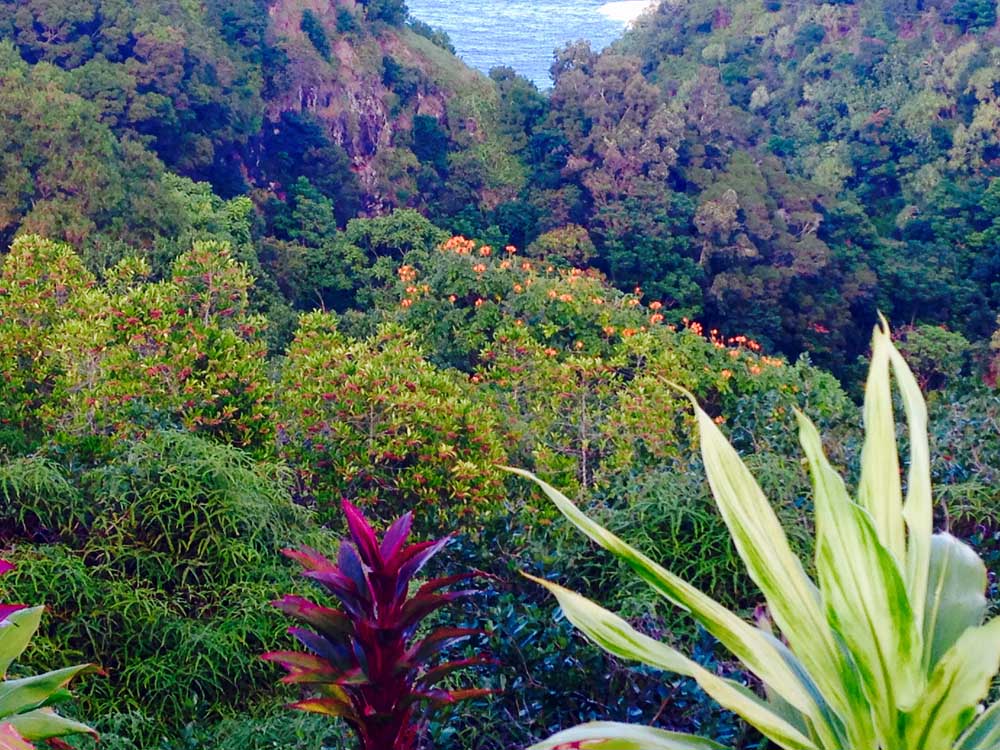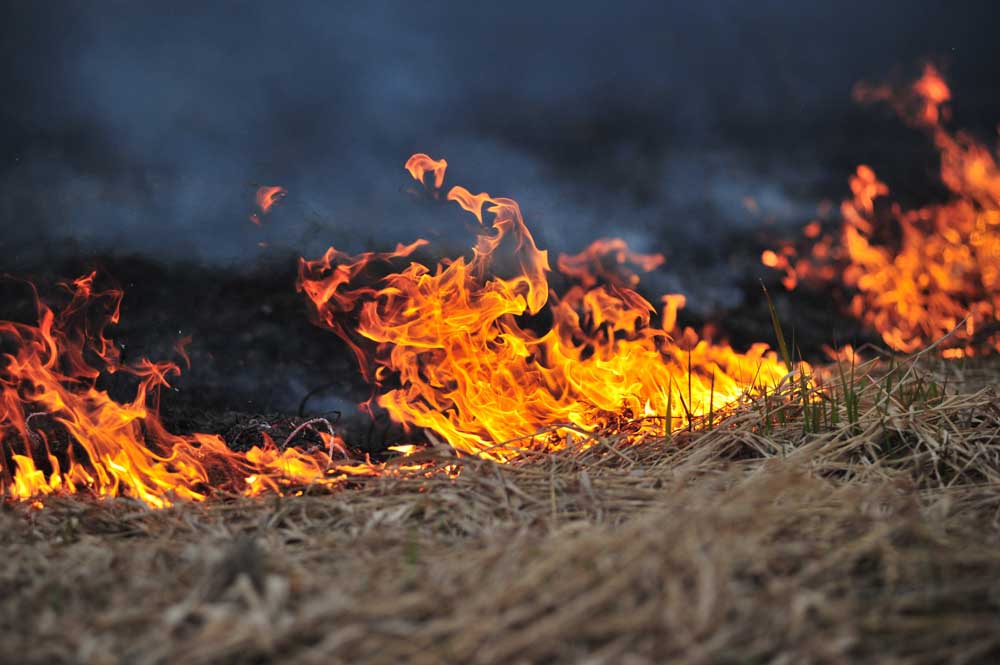Maui town preserves culture
Published 12:00 am Sunday, February 15, 2015

- John Gottberg Anderson / For The BulletinAfrican tulip trees, red ginger and prolific other flora help to make the drive along the Hana Highway one of the most beautiful in the world. Although the tulip tree is considered an invasive species, its blossoms are easily spotted throughout Maui.
{%comp-FFFFFF-bl%} HANA, Maui, Hawaii — I stood at the edge of a restless sea, surf lapping at my knees, a fishing net over my shoulder.
Broad-winged frigate birds, called ‘iwa, and white tropicbirds, known as ana’e, their lacy tails trailing behind them, circled in the warm, gentle breeze. A few snorkels poked above the water near an abandoned pier. The crew of an outrigger canoe paddled across palm-fringed Hana Bay toward a lava-rock island.
I was at the east end of the island of Maui. Beside me stood a broad-shouldered Hawaiian named Kepu, teaching me the basics of traditional throw-net casting. I had fished many times before, but always with a rod and reel. This was entirely different. I was holding a 9-foot net with weights attached around its perimeter.
{%pc-3488085%} At first, the casting technique seemed terribly complicated. Under Kepu’s tutelage, I began to get the hang of it. Holding a section of net in my right hand, I separated out a portion and hung it over my left elbow. Half of the remainder went over my right knee; the balance remained in my hand. I threw from all three places at once, forcing my hands straight out in the direction of a lava dike.
Kepu, born and raised in a Hawaiian ohana (an extended family), told me that he was taught to fish when he was 7 years old. “But I was always surfing all afternoon after school, then coming home at night and eating a lot — I mean, a lot — of food,” he recalled. “Finally, when I was 10, my father said, ‘Here’s a net. You’d better catch fish or you will go hungry.’ That was my first net, and it was when I really learned to fish.”
{%pl-3488097%} He told me about the fish that inhabit the reefs and shallow waters of east Maui: ulua (trevally), aweoweo (bigeye), uku (snapper), a’awa (hogfish) and others. I envisioned my catch and, with a little practice, coaxed the net’s ring to land flat on the water’s surface, allowing it to sink evenly and quickly to entrap fish within its 3-inch holes.
I soon netted a moi (Pacific threadfin), which Kepu told me is known as “the fish of kings” because, in ancient Hawaii, only the ali’i (members of the royal family) were allowed to eat it, its flesh considered so delicious. But I would have gotten only a couple of bites out of the 6-inch fish. I returned it to the water, and went without another catch the rest of the afternoon.
Benefits of isolation
One of the great joys of travel is in learning new things, whether or not we become adept at them. Unfortunately, the growth of tourism has homogenized many cultures, reducing their traditions to whatever may be saleable to the masses — for instance, in Hawaii, hotel luaus and Don Ho-style music.
Hana, however, is a different story. While luxury hotels in communities like Kaanapali and Kihei, on the west side of Maui, may be guilty of over-commercializing Hawaiian culture, such is not the case at the east end of the island.
{%pr-3491935%} Hana is remote. Hawaiian heritage is alive and well, as much as anywhere this side of the private enclave of Ni’ihau. (That small island, at the far end of the archipelago, is kapu — forbidden to any but native Hawaiians.) For the average haole (white) mainlander who ventures to America’s 50th state, Hana is about as isolated as one can get.
Fewer than 1,500 people live in Hana, and a majority of them claim Hawaiian bloodlines. The population once exceeded 3,500, but that was in the first half of the last century, before the sugar plantations closed. Most of the workers moved to the plantations in west Maui in 1946, but the Hawaiian people stayed, finding employment at the new Ka’uiki Inn.
That first step toward tourism had been made possible 20 years earlier by the completion of the Hana Highway from Kahului, the island’s main town and location of its inter-island airport. The 52 serpentine miles — now paved, but originally gravel — allowed sturdy vehicles to make the drive from the more populous part of Maui for the first time.
The label “highway” is a misnomer. The Maui Visitors and Convention Bureau says the road has 620 curves and crosses 59 bridges, 46 of which are only one lane wide. I didn’t count, but I have no reason to dispute these numbers. Without stops, it takes about 2½ hours to make the drive around the north side of the island, through dense rainforest on the flank of Hale’akala, a huge dormant volcano encompassed by a national park.
The road is two lanes with no shoulder, its potholes only intermittently patched, with frequent blind corners around which local drivers careen without honking in the dark. Hopefully, they have their headlights on. I wouldn’t drive this road after dark.
But why would you? The scenery en route is spectacular. Dozens of waterfalls, many of them drop-dead gorgeous, pierce the forest where the road twists over deep ravines overgrown with banana trees, hibiscus, figs and the beautiful but invasive African tulip tree. From time to time, the canopy opens to reveal verdant cliffs, hundreds of feet high, falling to impossibly blue waters and pocket beaches lapped with perfect, rolling surf. {%pl-3488096%}
The road to Hana
That was the scene this fall when photographer Barb Gonzalez and I flew from Portland to Kahului, with a transfer in Honolulu. The car-rental agent at the Maui airport told us to be careful driving the Hana Highway, but not to miss “the red sand beach.” “I can’t officially say that,” he said. “Visitors are discouraged because the trail is dangerous. But ask the locals. They’ll know.”
The trail couldn’t be any more dangerous than the road, we determined. The first section wasn’t bad, as we paused for an unforgettable lunch at Mama’s Fish House in Pa’ia and pulled over to watch the windsurfers — and green sea turtles, known to Hawaiians as “honu” — at Ho’okipa Beach Park, considered one of the top boarding spots in the world.
Then we began running the gauntlet. It seemed that every rain-fed stream flowing off the north slope of Hale’akala was showering our vehicle at each hairpin turn. We stopped often for photos, both at the falls and at a couple of arboretums displaying fine examples of native flora. If 2½ hours were the norm for the drive from Pa’ia to Hana, we took four. Or more.
One stop offered us a panorama of the lush peninsula of Ke’anae, taro fields surrounding its small farms, a church steeple rising above its palm trees. And as we drew nearer to Hana, we discovered roadside fruit stands and side roads to lava tubes, gardens, historic spiritual sites and even one ice-cream vendor: Coconut Glenn’s, about 5 miles before Hana, is famous for its dairy-free ice cream made from coconut milk, served in a half coconut shell at $5 a scoop.
{%pf-3488092%} A final turnoff near Hana led to Wai’anapanapa State Park, a black-sand beach surrounded by candlenut trees. Its main attraction, besides the water, is a pair of caves — one of them “wet,” filled with fresh water from stream drainage — that are linked to local legend.
Then we were in “town.” There’s not a lot to it: a couple of general stores, a police station and medical center, a single gas station ($5.24 a gallon), a small museum, a high school and library, several historic churches and a cross atop a hill. The village has a pizza joint, an open-air Thai cafe and couple of food trucks, open at their owners’ whims, but no theater, no coffee shop, certainly no brewpub.
The Travaasa experience
But it does have the Travaasa Hotel Hana, formerly the Hotel Hana-Maui and once the Ka’uiki Inn. Unlike the modern west Maui resort towers that strain for the last rays of sunset from Wailua north to Kapalua, Travaasa’s 70 bungalows are single-story dwellings, spreading across 66 acres from the highway to the sea.
These cabins face the sunrise. People get up earlier in Hana, where there’s no nightlife to speak of, save some early-evening slack-key guitar music in the Paniolo Lounge that adjoins the hotel’s Ka’uiki Restaurant.
And what a restaurant it is: Executive chef Konrad Arroyo offers his special version of “Hana fusion” cuisine, a locally foraged and fished menu that features fresh mahi mahi from Hana Bay, steamed with ginger in laulau (taro leaves), along with ke’e (octopus) poke, pohole (fiddlehead fern) salad, purple sweet potatoes and ulu (breadfruit) cake. “I want my farm right next to my restaurant,” Arroyo told me.
{%pr-3488093%} It was good that we were well-rested on our brief visit, because there’s so much to see and do. Barb enjoyed morning yoga in an open-air pavilion. I exercised my prowess, or lack thereof, at the ukulele. (Kepu walked me through the chords of “You Are My Sunshine,” then lapsed into Israel Kamakawiwo’ole’s popular version of “Somewhere over the Rainbow.”)
We also could have chosen from other Hawaiian experiences, including hula lessons and coconut husking, or such better-known sports as tennis, archery, bicycling and horseback riding. With limited time, we chose to explore just two other activities — throw-net fishing and outrigger canoeing.
Like the fishing, our canoe adventure took place on Hana Bay, a quarter-mile crescent framed by Nanu’alele Point and Pu’uki’i Island. Our instructors were Jerry, a muscular mainlander in charge of the resort’s activity center, and Mapuana, a local Hawaiian woman.
Jerry taught us the basics of paddling the “va’a,” the canoe, and the importance of synchronicity in our strokes to achieve maximum speed with minimum effort. There were separate commands to raise, ready and dip our paddles, to change sides on which we paddled, and to stop paddling.
Mapuana added a historical and spiritual element, telling us centuries-old stories of life on the bay. In calm waters in the wake of Pu’uki’i Island, she chanted in Hawaiian: “Everybody paddle the canoes together. Bail and paddle, paddle and bail, and the shore shall be reached.” {%pl-3488091%}
Through Kipahulu
Before leaving Hana, we did find the Red Sand Beach. This sheltered cove of fine, rust-colored volcanic grit was pocketed within lofty bluffs and protected from onrushing surf by a prominent reef. A couple of dozen swimmers and sunbathers enjoyed relative privacy as a few adventurous young men climbed the rocks of the reef and leaped into the calm waters.
The beach may be off limits, but the message didn’t get to the numerous cars parked on a hilltop drive just outside the Travaasa property, where a well-trod trail disappears into thick foliage. A prominent sign warned: “The Trail Is DANGEROUS. Land is subject to landslides. Landowner will not be liable for any injury to any person.” But I found the trail only slightly more dangerous than the road to Hana itself.
There’s much more to say about the Hana coast and precious little space to say it. The two best surfing beaches, Koki and Hamoa beaches, are a couple of miles south of town and just off the highway via Haneo’o Road. About 5 miles farther, the road enters the Kipahulu section of Hale’akala National Park, itself worth a full day’s excursion.
A highlight is the spectacularly beautiful site known as the Pools of ‘Ohe’o, or the “Seven Sacred Pools.” This series of cascades, one pond flowing into another along the Palikea Stream until it reaches the ocean, is best viewed from a short trail departing from the park’s visitor center. For more energetic visitors, the 2-mile Pipiwai Trail ascends through rainforest — and a stunning bamboo forest — to the foot of 400-foot Waimoku Falls, where some hikers shed clothes to cool off in a deep pool.
{%pr-3488084%} That activity might be frowned upon at the Palapala Ho’omalu Church down the road. The missionary church, built of coral in 1864, is best known for its tiny cemetery, which holds the grave of pioneer aviator Charles Lindbergh (1902-1974). Nearby are the Ono Farms, which welcomes visitors for tastings of several dozen exotic fruits grown here, among them starfruit, rambutan, jackfruit, guava, lilikoi (passion fruit), dragonfruit, bilimbi and the aromatic durian.
Unless you rent a four-wheel drive vehicle, as we did, your rental-car contract won’t cover travel around Maui’s southeastern shore, although the road is barely worse than the Hana Highway. Cautious drivers may want to turn around and return to west Maui on the main road.
West Maui
The rest of the island is better known to most casual tourists. The historic whaling port of Lahaina is a popular destination, both for its rollicking shopping-and-nightlife scene along Front Street, and for excursions to the nearby island of Lana’i aboard the catamaran “Trilogy” and other excursion boats. Lahaina was the first capital of the united Kingdom of Hawaii in the late 1700s, and the town of 12,000 is proud of its heritage.
Between Lahaina and the other main resort strip of Kihei-Wailua is Maui’s principal harbor, Ma’alaea. A fine aquarium, the Maui Ocean Center, is a good place to get acquainted with local undersea life before boarding the “Alii Nui,” a catamaran that provides equipment as well as food and drink on five-hour snorkeling trips to the islet of Molokini, its inundated crater walls harboring a marine reserve.
{%ssc-3488086,3488087,3488089,3488090,3488095,3488098,3488099,3488100,3488101%}
{%qc-It’s a long way from the restless sea.%} Another island attraction is Iao Valley State Park, a short drive west of Wailuku, the erstwhile Maui County seat. It is dominated by Iao Needle, a vegetation-covered lava spike that rises 1,200 feet above the valley floor in the West Maui Mountains, and a designated “national natural landmark.” The Kepaniwai Park Heritage Gardens extend nearby.
{%tl-BDBDBD, 000000, 2%} And then there’s Hale’akala, the “house of the sun.” Maui’s lone national park embraces the crater and hinterlands of a dormant volcano, 10,023 feet in elevation. Seven miles east-west, two miles north-south and half a mile deep, the crater wilderness is crisscrossed by more than 30 miles of hiking trails served by cabins and campsites for the intrepid. Unique plants, such as the yucca-like silversword, and rare birds, including the ‘i’iwi, a scarlet honeycreeper, make their homes within the crater.
Most visitors are satisfied with a steep, switch-backing sunrise drive to the visitor center at 9,740 feet. It’s a long way from the restless sea.
— Reporter: janderson@bendbulletin.com.








